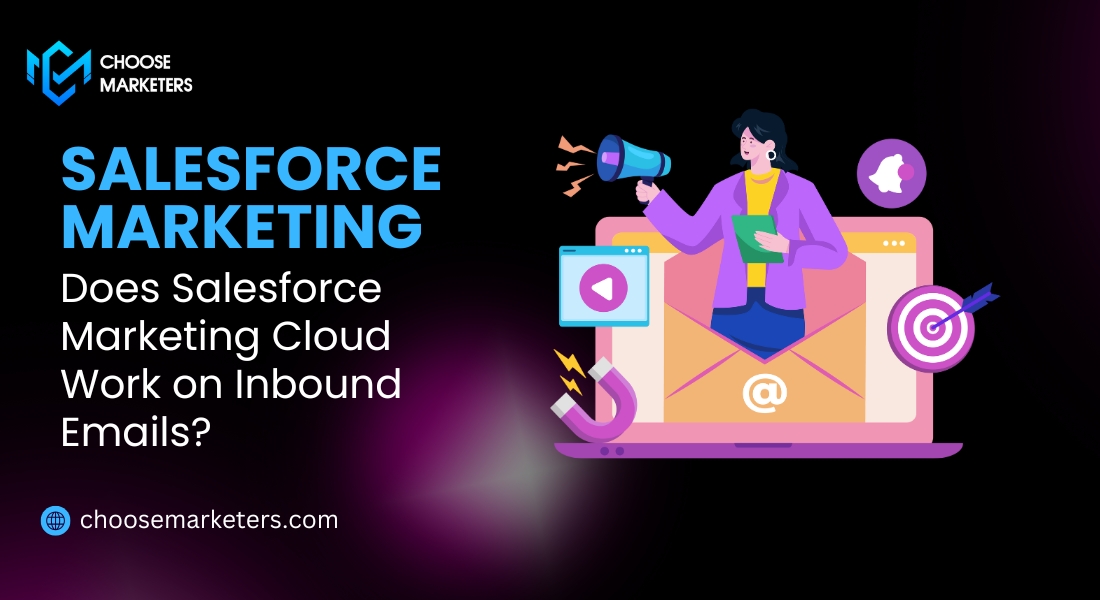

Does Salesforce Marketing Cloud Work on Inbound Emails?
Yes, Salesforce Marketing Cloud (SFMC) does work with inbound emails, though its primary focus is on outbound marketing campaigns. Tools such as Email Studio and Journey Builder in Salesforce Marketing Cloud, along with integrations or add-ons, typically support inbound email functionality and enable more robust management of inbound interactions. Here’s how Salesforce Marketing Cloud works with inbound emails:
1. Data Collection and Integration
Salesforce Marketing Cloud can capture data from inbound emails through a variety of methods, including:
Triggered Email Sends: When an inbound email event (such as a response or submission) occurs, SFMC can automatically trigger a follow-up email or store the response data.
API Integration: By integrating with other systems, SFMC can capture and analyze inbound email content. For example, using Salesforce’s REST or SOAP APIs, inbound emails can trigger workflows in Journey Builder or update CRM records.
2. Inbound Data for Campaigns
Marketers can use inbound email data to inform outbound marketing campaigns. They can integrate customer responses, preferences, or feedback into the Email Studio database to segment audiences more effectively. For instance:
Custom Data Fields: Inbound email responses can be used to update contact records or trigger dynamic content changes in future email campaigns.
Event Triggers: Responses from inbound emails can trigger new journeys, personalized campaigns, or even specific offers based on the user’s interaction.
3. Interaction Studio for Real-Time Engagement
While Email Studio focuses on email marketing, Interaction Studio (an add-on feature) enhances Salesforce Marketing Cloud’s inbound capabilities by providing real-time interaction management. This can include tracking inbound email behaviors and allowing real-time decisions based on those actions, like sending tailored responses, updating customer profiles, or even activating multi-channel workflows.
4. Einstein AI for Email Engagement
Salesforce’s Einstein AI can analyze inbound email patterns to improve future marketing efforts. Einstein Engagement Scoring can analyze past email behavior, including interactions with previous inbound emails, to optimize content and delivery times for future campaigns.
5. Customer Service and Sales Cloud Integration
Salesforce Marketing Cloud is often used in conjunction with Sales Cloud or Service Cloud, which have more robust tools for managing inbound emails. For example:
Service Cloud: Used to manage inbound customer service inquiries, which can then trigger marketing journeys in Marketing Cloud.
Sales Cloud: Inbound emails received by sales teams can inform Marketing Cloud campaigns, helping nurture leads more effectively.
6. Marketing Automation via Journey Builder
With Journey Builder, inbound emails can serve as triggers for marketing automation workflows. For instance:
A user responding to a survey or offer can trigger a new sequence of targeted follow-up emails.
A customer reply to an inbound email can be the starting point for a tailored email journey based on their preferences or actions.
Inbound Email Limitations
While Salesforce Marketing Cloud supports inbound emails, it’s not designed as a full-fledged email inbox management platform like customer service solutions such as Service Cloud or third-party email clients. Therefore, managing large volumes of direct email conversations may require additional integration with CRM systems or customer service tools.
Overall, Salesforce Marketing Cloud supports inbound emails primarily as part of larger marketing automation workflows, rather than serving as a comprehensive email management platform.
Step-by-Step Process: How Salesforce Marketing Cloud Handles Inbound Emails
If you’re looking to use Salesforce Marketing Cloud to manage inbound emails, here’s a simplified process to guide you:
1. Set Up Email Studio
Email Studio is the key module for handling emails within Salesforce Marketing Cloud. To begin managing inbound emails, you first need to set up the system to send and receive emails.
Create Email Campaigns: Design and send campaigns to engage your audience.
Ensure Reply Management: Configure the system to accept responses from your recipients.
Use ‘From’ Addresses: Make sure the emails are sent from a monitored address capable of receiving inbound emails.
2. Integrate Journey Builder
Salesforce’s Journey Builder allows you to automate customer journeys based on real-time data, which includes inbound emails.
Trigger Journeys Based on Responses: Once an inbound email is received (for example, a response to a promotional email), Journey Builder can automatically trigger different workflows.
Create Decision Splits: Depending on the inbound content, you can create decision splits in Journey Builder. This means if a user replies positively or negatively to an email, you can trigger a specific journey for that user.
3. Use Interaction Studio for Real-Time Personalization
Interaction Studio tracks how customers interact with your emails and website, including inbound email responses.
Analyze Responses: Track inbound emails to understand customer sentiment, which can then be used to personalize follow-up messaging.
Real-Time Updates: As inbound emails come in, you can use Interaction Studio to modify ongoing journeys or trigger new actions based on this data.
4. Integrate with Service Cloud or Custom Workflows
To handle more complex inbound email processes, such as support requests or inquiries, you may need to integrate Salesforce Marketing Cloud with Service Cloud or other workflow tools.
Service Cloud: This provides advanced features for case management and support tickets, which can be linked with Marketing Cloud campaigns.
Custom Workflows: You can build workflows to automate actions based on inbound emails, such as triggering specific responses, flagging important messages, or routing them to different teams.
5. Monitor and Analyze Email Performance
SFMC offers comprehensive reporting tools that allow you to analyze both inbound and outbound email performance. By monitoring responses, you can adjust campaigns and messaging to improve engagement.
Understanding Salesforce Marketing Cloud
Salesforce Marketing Cloud is a comprehensive platform designed to manage and enhance customer engagement through digital marketing. It provides tools for creating personalized marketing campaigns, managing customer journeys, and automating workflows across different channels, including email, SMS, social media, and websites.
Features of Salesforce Marketing Cloud:
Email Studio: For creating, managing, and sending personalized email campaigns.
Journey Builder: For automating customer journeys based on interactions and behaviors.
Interaction Studio: For real-time interaction tracking and personalization.
Social Studio: For managing social media marketing.
Audience Builder: For segmenting and targeting audiences based on data insights.
Salesforce Marketing Cloud focuses heavily on outbound marketing activities by sending highly targeted messages to customers. However, it is equipped with features that also allow you to respond to and track inbound emails, ensuring that the conversation between your brand and customers remains continuous and personalized.
What is Inbound Marketing?
Inbound marketing is a strategy that focuses on attracting customers through content and interactions that are valuable and relevant to them. Rather than pushing out mass messaging (outbound marketing), inbound marketing aims to create meaningful engagements that draw people to your brand naturally.
Elements of Inbound Marketing:
Content Creation: Providing valuable content (blogs, whitepapers, emails) that addresses customer pain points.
Email Campaigns: Sending helpful information or offers that encourage prospects to take action.
Lead Nurturing: Building relationships with leads through personalized content based on their behavior and needs.
SEO and Social Media: Using search engines and social platforms to organically attract potential customers to your brand.
The core of inbound marketing is about fostering relationships and building trust, positioning your brand as a helpful partner in the customer journey. Emails, particularly, play a critical role in inbound marketing by allowing brands to continue the conversation once a lead has been generated.
How Are Salesforce Marketing Cloud and Inbound Marketing Related?
Salesforce Marketing Cloud is perfectly aligned with the principles of inbound marketing. While it excels in sending targeted outbound campaigns, it also offers tools that enhance the inbound marketing process through personalized content, journey automation, and real-time engagement tracking. Here’s how they connect:
1. Email Campaigns and Customer Engagement
Salesforce Marketing Cloud allows you to send highly personalized and segmented email campaigns that can serve as the backbone of an inbound marketing strategy. These campaigns not only promote your products or services but also offer value by educating or entertaining your audience, encouraging them to engage further with your brand.
2. Lead Nurturing Through Automation
Inbound marketing thrives on building long-term relationships with leads, and Salesforce Marketing Cloud’s Journey Builder makes this process effortless. By creating automated workflows, you can send nurturing content to prospects as they interact with your brand, ensuring that every email is relevant to their current position in the customer journey.
3. Data-Driven Personalization
Inbound marketing relies on delivering personalized experiences, and Salesforce Marketing Cloud excels at this with its real-time data processing capabilities. Interaction Studio, for example, can analyze how a customer engages with your emails and other channels, allowing you to adjust messaging based on their behavior.
4. Handling Inbound Responses
One of the challenges of inbound marketing is managing responses and feedback from customers, and Salesforce Marketing Cloud addresses this with tools for tracking inbound emails and adjusting future campaigns accordingly. Whether it’s an inquiry, a support request, or a simple reply to a campaign, the platform ensures that every inbound message is captured and responded to appropriately.
5. Optimizing the Customer Experience
Ultimately, inbound marketing is about creating a seamless, positive customer experience, and Salesforce Marketing Cloud provides the tools to manage this across multiple channels. By automating repetitive tasks, tracking engagement in real-time, and offering personalized content, SFMC ensures that every touchpoint with your brand is meaningful and valuable to the customer.
FAQs
Does Salesforce Marketing Cloud support inbound email handling?
Yes, Salesforce Marketing Cloud supports inbound emails through features like Journey Builder and Email Studio, though it may require integration with tools like Service Cloud for advanced inbound email management.
Can Salesforce Marketing Cloud automate responses to inbound emails?
Yes, Salesforce Marketing Cloud can automate responses to inbound emails using Journey Builder to trigger workflows based on customer interactions and replies.
Is Salesforce Marketing Cloud suitable for inbound marketing strategies?
Absolutely. Salesforce Marketing Cloud’s automation, personalization, and engagement tracking capabilities make it an ideal platform for inbound marketing strategies.
What role does Interaction Studio play in inbound marketing with SFMC?
Interaction Studio tracks customer interactions in real-time, including inbound emails, allowing marketers to adjust their campaigns and personalize responses based on real-time data.
Do I need additional Salesforce products to handle inbound emails in SFMC?
For more advanced inbound email management, such as support ticketing or inquiries, integrating SFMC with Service Cloud or creating custom workflows may be necessary.
How can I track inbound email responses in Salesforce Marketing Cloud?
You can use features like Journey Builder and Interaction Studio to track and analyze inbound email responses, segment your audience, and trigger appropriate follow-up actions.
Salesforce Marketing Cloud offers a powerful suite of tools that not only enhance outbound email campaigns but also manage inbound emails effectively. While primarily an outbound-focused platform, it can work within an inbound marketing strategy by automating responses, tracking customer journeys, and integrating with other Salesforce products. For businesses seeking to build meaningful, data-driven relationships with their customers, leveraging Salesforce Marketing Cloud for inbound and outbound email management is a winning strategy.

